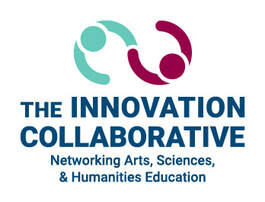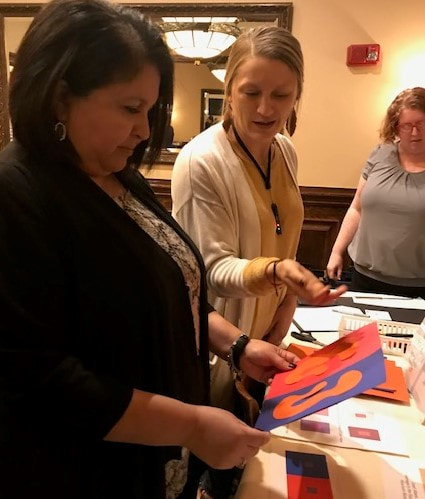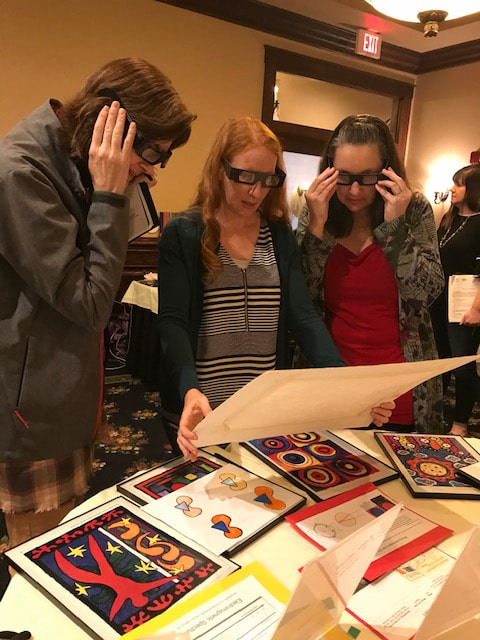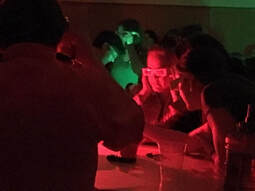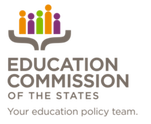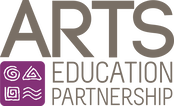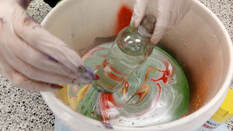 By Julie Olson, Collaborative STEM Innovation Fellow and award-winning science teacher at Mitchell Senior High/Secondary High School, Chance,South Dakota What started out as an idea for our Physic Photo Contest turned into a full- blown, very engaging STEAM learning experience for several at-risk science students. The photo contest, in itself, is a great STEAM project in which students explain the science behind a natural or contrived photograph. Here’s how the project worked with my students: A student chose to photograph and explain the hydro dipping process using a plastic soda bottle. The basic hydro dipping process involves putting spray paint on the top of a tub of water, swirling it with a stick, then dipping an object into the water. Choosing the colors, the amount of stirring affect the process. As I wanted to capitalize on a teachable moment, I explained the science behind hydro dipping. That explanation prompted me to start thinking how I could make deep connections, excite my students about learning, and develop a great STEAM unit. The next day, I discussed hydro dipping with some students who were not very excited about their Chemistry lesson. We talked about the basics of the process: a non-polar (molecules do not have a charge) substance such as paint is floating on water that is polar (molecules have a charge). The paint floats because of the density, and unlike substances, do not mix. Working together, we produced a couple of swirled plastic bottles. One student added to the conversation by noting that he had a motorcycle helmet “dipped” but with a skull design! The questions started flowing. How was that done? What did they use? The fire had been lit! We investigated and found that, in commercial processes, there are special paper and inks used to print designs. What was the cost? What kind of ink? What was the paper coated with? So, yes – more questions and thus ensuing investigations to do. The lesson depended upon having printers available that used pigment-based inks instead of dye-based. The dye-based inks are water soluble and would bleed as well as focus the color. Pigment-based inks are water insoluble and reflect light. Photography uses pigment-based inks, while most ink-jet printers use the dye water-soluble inks. The paper was then coated in PVA (polyvinyl alcohol), which is a component of glue as well as hairspray. It is water soluble. So, our investigation began as we had to find out how to create a PVA film and what to place it on. Just trying a variety of papers (e.g. wax, parchment, cardstock, foil, and plastic bags) and PVA sources (e.g. hair spray, white glue, and wood glue) was a great exploration into materials. We have now created some films and students have drawn preliminary designs on paper to later transfer it to the PVA film. But there are still intriguing questions to answer: How long does the film has to float on the water? How hot does it need to be? What is the fixative? These questions and subsequent investigations are fueling the students’ desire to learn as well as giving them a personal connection to that learning through the creation of a work of art. This is a STEAM lesson that other teachers could easily adapt for their own science and/or visual arts students. I know that it is a lesson that I will definitely repeat my students!
0 Comments
From the Field
Everyone has been impacted by the new COVID-19 reality. Teachers, especially, have been impacted, as they have had to develop new and effective ways to continue to work with their students. One of the Collaborative’s current online STEAM teacher professionals, Ronda Sternhagen, has demonstrated how Collaborative thinking skills are useful for schools as they adapt to this new reality. Ms. Sternhagen teaches grades 5-12 visual art at Grundy Center Middle School and High School in Grundy Center, Iowa. Define the problem. School districts are trying to figure out how to deliver content to their students. Questions like, who has Internet access and who does not? Who has a device to access online content and who does not? There are more questions than answers right now but the first step is to identify all the challenges. Change perspectives. One has to ask themselves, "Is this truly something that I have to leave my home for?" Do I really need to run to town for one or two items or can I wait? This involves changing perspectives from supply needs to health needs. Collaborate. The coming together of teachers and other community members to make masks and donate them to first-responders is a great example. Create. For instance, in my community, we are creating virtual choirs and with teachers and a staff video for our students Communicate. While educators try to find new and innovative ways to communicate with their students, teachers are also finding new ways to communicate with one another. In my case, being in a rural district with about 400 students in the 5-12 grade building, staff is close - you know everyone. A group of us now have a scheduled Google Hangout every Monday and Thursday night at 9:00 pm just to chat, hang out, find out what everyone is doing, how our own families are getting along, etc. These are just a few creative ways that we’re adapting to our current situation in my community. How are you using your creative and innovative thinking skills in adjusting to COVID-19? Thanks in part to support from the National Endowment for the Arts, the Collaborative is conducting the third phase of its STEAM teacher professional development effective practices study. In its two previous studies conducted during the 2017-18 and 2018-19 school years, it discovered some important effective practices in STEAM professional development. In the 2019-20 study, it is investigating the best forms of disseminating these effective practices.
To do that, it is comparing a hybrid professional development consisting of in-person and virtual training versus completely virtual training. It also is examining the most effective practices in each of these modes of delivery. Helping lead this project are the Collaborative’s researcher, Bess Wilson, Ph.D. Assistant Professor, Department of Foundations and Secondary Education, University of North Florida; Lucinda Presley, Collaborative Executive Director; the Collaborative’s Innovation Fellows, the top 10 teachers identified in the first round of research; and a number of their school administrators. They represent K-12 from the following states: Florida, Iowa, New Hampshire, North Carolina, South Dakota, and Texas. These Collaborative staff, Fellows, and administrators met virtually and then in person in Houston, Texas in November 2019. There, the Fellows helped Dr. Wilson and Ms. Presley train the administrators in STEAM intersections using discussions, in addition to hands-on and creating activities. The group then planned the teacher and administration professional development dissemination models and methods for implementation in spring semester, 2020. During this semester, there has been success in the hybrid training. Additionally, an online teacher professional development platform was developed and select teachers and administrators were invited to participate. While a limited request was sent out, the response was overwhelming. Due to limited capacity, 67 of the teachers and administrators who applied were accepted. They hail from various states, all grade levels, and a wide variety of disciplines. These disciplines include: all visual and performing arts, science, technology, engineering, math, social studies, special education, and English as a second language. These teachers and administrators have learned about the Collaborative, what STEAM is, the Collaborative’s thinking skills and its continuum of STEAM integration. After learning about the Collaborative’s rubrics and assessment, the plan was for the teachers to implement and use the rubrics to assess one the Collaborative’s top 10 lessons and a STEAM experience they created. To adapt to the wide variety of schools’ responses to the coronavirus, adjustments were made that allowed teachers and administrators to accomplish this choosing from a variety of options from the Collaborative. They also worked together to develop further creative means of implementation. Highest praise goes to the teachers and administrators who persisted, in spite of overwhelming odds, and are completing the course. They also were given resources, learned how to extend their learning, and received STEAM credentialing as a STEAM professional. 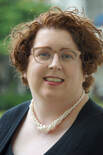 By Dr. Hope E. Wilson, Collaborative Board member and researcher, and Assistant Professor, Department of Foundations and Secondary Education, University of North Florida As the Innovation Collaborative worked to promote highly effective practices for STEAM education, it became apparent that we needed a way to measure the impact of these practices on students. As a result of this work, 4 different rubrics were developed. The background of the research can be read in this article about the rubrics. Wilson, H. E., & Presley, L. (2019). Assessing creative productivity. Gifted and Talented International, 31(4), https://doi.org/10.1080/15332276.2019.1690956 In this article, we will give you a brief overview of how you might be able to use these rubrics in your own practice as an educator, administrator, or STEM, humanities, or arts advocate. Lesson Rubrics The first set of rubrics is designed to help teachers evaluate their lessons. In these rubrics, teachers and evaluators can assess the extent to which a lesson provides opportunities for students to either integrate STEAM content and/or exhibit thinking skills. They include the Content Lesson Rubric and the Thinking Skills Lesson Rubric. Student Product Rubrics The second set of rubrics is designed to help teachers evaluate student products. In these rubrics, teachers and evaluators can assess the extent to which students either integrate STEAM content and/or exhibit thinking skills. They include the Content Student Product Rubric and the Thinking Skills Student Product Rubric. Content Rubrics Now, let's take a deeper dive into the specifics of each rubric, starting with the content rubrics. The content rubrics (for lessons or for student products) are meant to measure the extent to which the lesson or the student product demonstrates the content areas. There are three components to each of the content rubrics: Degree of Integration, STEM Content, and Arts or Humanities Content. Degree of Integration The degree of integration criterion is based upon the continuum of integration. The scale measures from low levels of integration (single disciplinary) to complex and deep integration (transdisciplinary).Think about how much the lesson offers opportunities for students to connect content areas together and how much the content areas depend on each other for the lesson to be successful. For student projects, you are evaluating how much the students are able to integrate the different disciplines together. STEM Content The STEM content criterion is based upon the quality of the science, technology, engineering, or mathematics content. This scale measures from surface-level understanding to deep, rich understanding of big ideas. This can be evaluated for how the lesson developed opportunities for understanding or for how the student demonstrated the understandings. Arts or Humanities Content The Arts or Humanities content criterion is very similar to the STEM content criterion. You will be measuring how well the lesson elicits this understanding or how well the student is able to demonstrate this understanding. You also may be assessing the students' skills or performance. Thinking Skills The next set of rubrics are based upon the thinking skills that were developed by representatives from Collaborative arts, STEM, and humanities institutions, with guidance by its Research Thought Leaders, top researchers in each field. Each of the rubrics (for lessons and for student products) have 6 criteria: Synthesis and Transformation, Generalizations and Applications, Problem Solving, Visual Analysis, Persistence, and Collaboration. Synthesis and Transformation This criterion is where the rubric captures the creativity of the student products or the ability of the lesson to elicit creativity from students. Depending on the project, you might be thinking about fluency (the number of ideas generated), originality (how unique the ideas are), relevancy (if the solution or product solves the problem in an innovative way), imagination or fancifulness (creative solutions that might not be practical), or synthesis (putting different ideas together to make a new idea). Generalizations and Applications In this section of the rubric, you are evaluating the lesson on how it gives opportunities for students to make generalizations or applications, or how well the students are able to apply their knowledge. These ideas are related to analysis of problems and ideas, scientific practices, inferencing strategies in reading and science, and examples in mathematics. Students with the highest scores in these categories will be able to make generalizations and applications that show both deep understandings and unique ways of thinking. Similarly, lessons that score highly in this category will provide open-ended opportunities for applications and generalizations, with multiple ways for students to respond. Problem Solving The problem-solving criteria refers to any (and all) of the stages of all manners of problem solving, such as engineering, artistic, and creative problem solving. Although STEAM lessons at times may not use the entire process (from asking questions to evaluating the solution), framing the lesson around portions of the process can be helpful to demonstrate the thinking skills that students are using in the lessons. For example, students may be provided opportunities to define the problem or assignment, when given looser parameters, or evaluating possible solutions if they brainstorm ideas before selecting their final project (e.g., making thumbnail sketches in art). Visual Analysis Visual Analysis refers to the process of looking, observing, and analyzing objects, materials, or other resources to gain information. This is a process that can be used in science (e.g., observations done in laboratory settings), engineering (e.g., form follows function), dance (e.g., the movement of the body), and is an important component of the STEAM curriculum. You will evaluate both the lesson's opportunities for visual analysis and the students' use of the visual analysis skills. Persistence Persistence is the ability of a student, or group of students, to continue when they face challenges, setbacks, or sense failure. High-quality lessons provide opportunities for students to experience setbacks and also to provide structure and support for students to continue. The most successful students are able to learn from their mistakes and setbacks and continue moving forward. Collaboration The last criterion involves collaboration. Through our research, we have found that collaboration has been an integral part of student success in STEAM activities. The most successful lessons involve giving students opportunities to collaborate, either in the creation of products, the generation of ideas, or the evaluations of final products. Students who are able to successfully collaborate with peers demonstrate high levels of thinking skills. A Few Notes It is not expected that every lesson or every student product would demonstrate all of the listed criterion. That would make planning a lesson almost impossible! However, we do know that the most successful lessons that engage the students the most in STEAM activities incorporate many of these criteria. We hope that the rubrics are helpful to you, not only in evaluation and assessment of lessons, but also as reflection and planning experiences for your students. Hopefully, they can help you as you think about STEAM lessons in your own classroom or school contexts. 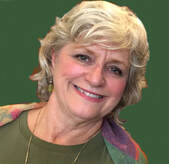 The Collaborative’s Research Thought Leaders help provide the strong foundation upon which the Collaborative’s work rests. Each Thought Leader is nationally and internationally recognized in their own field and brings an extensive depth of experience and expertise. They also are adept at working across disciplines. A Thought Leader is featured in each Collaborative newsletter. In this issue, we visit with Bonnie Cramond, Ph.D. Bonnie is Professor Emerita of Educational Psychology and Gifted and Creative Education at the University of Georgia (UGA) and the former Director of the Torrance Center for Creativity and Talent Development at UGA. She is known for her research in the assessment and development of creativity, especially among at-risk students, and for her extensive work in the creativity field. In a conversation with Collaborative Executive Director Lucinda Presley, Bonnie talked about her work and its relationship to the Collaborative, in addition to personal reflections on her mentor, Dr. Paul Torrance. Paul Torrance was an educational psychology professor at the University of Georgia and is called “the father of creativity.” He is known for developing the Torrance Test for Creative Thinking, which is the benchmark for assessing creativity. Tell us about your career in creativity, Dr. Torrance, and the Torrance Center. I got interested in creativity while teaching 5th grade students at Woodland West in Jefferson Parish, outside of New Orleans. I was inspired by how they “took off” when I did creative things with them. For example, they were inspired by the Guinness Book of World Records to create their own Woodland West Book of School Records. They created their own categories, such as who could say the alphabet backwards the fastest. They organized school competitions, wrote up the findings, and were able to get it published for the school. The school district took notice of this and then asked me to teach gifted students. Though there were no requirements for this back then, I took a summer course on gifted education at the University of New Orleans and, in the course of study, fell in love with the work of Dr. Paul Torrance. I then entered the University of Georgia graduate program and studied with Dr. Torrance When I finished my Ph.D., I taught gifted education in middle school in Lafayette, Louisiana. I also taught gifted education, creativity, and educational psychology at the University of Southeastern Louisiana and at Western Illinois University. When Dr. Torrance retired, I was encouraged to apply for his position since I had studied with him extensively and was accepted. He became a great mentor for me in my teaching and research for the rest of his life. He was known for his generosity. For example, he anonymously paid for assistantships for students in his department. No one knew about this until he retired. Since he had no heirs, when he died, he even left his house to the graduate student who rented an apartment from him on the premises and who, along with me, took care of him in his later years. He left what money he had to the university and all royalties from his books and tests to the Torrance Center at the university. During this time, the Torrance Center for Creativity and Talent Development was established at the University of George (UGA). I was named the fourth director of the Center. Although I also had a full load of classes to teach at UGA, I was able to help the Center thrive. The Center focuses on research, education, and service. For research, its goal is to facilitate and cooperate in creativity research, building on Dr. Torrance’s research. Thanks to Dr. Torrance, the University of Georgia rare book library has the largest collection of resources on creativity in the world. Scholars come from all over the world to conduct research. In focusing on education, the Center trains classroom teachers worldwide in creativity education. For service, it conducts Saturday and summer programs for kids. It also hosts the Duke University Talent Identification Program (TIP) each summer and on weekends for gifted middle and high school students. How does your work at the Torrance Center relate to your research? I became interested in how creative students are perceived and accepted. I was interested in how we find creativity in kids and how we nurture it. I hope that what I discovered can help teachers and students in their classrooms. I was influenced by Dr. Torrance’s observations that many of the creative kids he worked with were like wild ponies, and that we must harness their energy and direct it in a positive way. Part of my work was driven by my concern that kids were being labeled ADHD (attention deficit/hyperactivity disorder) when they were actually highly creative. I worried that the numbers of kids on Ritalin was way too high – as high as 30% in some schools - and that many more kids were on these drugs in certain geographic areas. In one of my early papers (see resources below), I showed how the descriptions of ADHD and creativity were the same. I got kids who were in a special program for highly creative kids and ADHD kids to do the Torrance Test for Creative Thinking. I found that about 20% of the highly creative kids scored high on ADHD behaviors and that a third of ADHD kids scored high on creativity. I concluded that there are kids with both ADHD and creativity and that there also are some kids who are highly creative but are misdiagnosed. My concern was that teachers aren’t taught what creativity looks like and I wanted to help educators see that a creative student can be the class clown, marching to a different drummer. I was initially attacked for my findings, but recent psychological findings are showing the similarities between ADHD and creativity (see resources below). What have you discovered in your research that points to the importance of the Collaborative’s work? I have been to more than 40 countries talking about creativity and one of the big issues I’ve found is that when you mention creativity, people only think of art. While art involves a great deal of creativity, you also can express creativity through any human endeavor. For, creativity is looking at something in a different way, solving a problem in a new way, or expressing something in an original and evocative manner. The sciences, technology, enginering, and math (STEM) especially need creative thinking, for that is where our biggest breakthroughs come in. They often don’t see the need for creativity. That is where the Collaborative comes in. It is showing that creativity has a big place in STEM and through STEAM. In talking with a chemistry professor at UGA, I learned that STEM has trouble keeping females and minorities in the STEM pipline toward careers because they think STEM is so dry. One of the solutions, I believe, is in showing the importance of creative thinking in STEM courses early on, not just focusing on the formulas and the rules. A good example comes from astronomer Carl Sagan. In his article “Wonder and Skepticism”, he pointed out that science involves wonder – complete openness to new ideas – and skepticism - distinguishing between the right and wrong ideas. And one shouldn’t overpower the other. Professor Jason Cantarella, professor of mathematics at UGA, likens this to music. He points out that if we taught music like they teach math in schools, we would only teach the music scales and not get to play the beautiful music. Too often in academia we focus too much on the skepticism and not on the wonder, too much on the scales and not on the music. It’s the creativity that helps bring in the wonder and the “music”, and the Collaborative is helping with that. Do you think the Collaborative is moving the creativity/innovation fields forward? The Collaborative is definitelty moving these fields forward. It is helping show the important role these skills play in education and in all fields. It’s also showing how effective collaboration works with teachers, lessons, and evaluation. I don’t see anyone else doing this to this extent on a national level. And the Collaborative’s work is having a national impact that can affect all grade and content levels. How do you see the Thought Leaders and the Collaborative benefitting from their work together? In recent years, more research has come out showing how innovation comes from the juxtaposition of two fields. When you have two people with two different fields working together, it’s exponentially beneficial. I am energized by seeing what other people are doing, such as the other Thought Leaders. Also, while we are helping bring important information to teachers, we are also learning from them and from the Collaborative members. Are there any other thoughts you would like to share? I feel so honored to be a Thought Leader. To get to work with all these people has been so exciting and beneficial. I’m so impressed with this work! Resources that address Dr. Cramond’s research: Bonnie Cramond. The Relationship between Attention-Deficit Hyperactivity Disorder and Creativity. https://eric.ed.gov/?id=ED371495 Bonnie Cramond. The Coincidence of Attention Deficit Hyperactivity Disorder and Creativity. Attention Deficit Disorder Research-Based Decision-Making. https://eric.ed.gov/?id=ED388016 The Creativity of ADHD https://www.scientificamerican.com/article/the-creativity-of-adhd/ Learn more about Dr. Torrance.
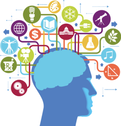 By Lucinda Presley, Collaborative Executive Director Nationally recognized researchers, educators, businesses, in addition to research studies, point out that the United States’ future in the global economy could be significantly impacted by how well today’s students are taught to think creatively and innovatively. The foundation of the work done by the Innovation Collaborative is the promotion of these creative and innovative thinking skills in today’s students. A collaborative team of representatives from national arts, STEM, and humanities institutions developed the Collaborative’s list of these skills over a year and a half when the Collaborative was founded. These thinking skills now form the foundation of the Collaborative’s Effective Practices Rubrics that are used to assess effective practices in STEAM education in K-12 classrooms in all disciplines. They also have been studied and successfully statistically validated. They are important thinking skills that our students need from Pre-K throughout their education careers to enable them to be effective contributors to our future workforce. Interestingly, to successfully navigate the myriad and highly interconnected aspects of our lives impacted by the COVID-19 virus sweeping our nation, all of these Collaborative creative and innovative thinking skills are needed. Here are some examples of how workers and leaders can use these thinking skills to address the impact of COVID-19. Define the problem. For example, define their specific problem to solve in areas such as medical supply shortage, food shortage, and disease transmission (and each of these problems has many sub-problems to address) Evaluate all the necessary information. For example, determine which is the most important - and accurate - information to use in solving the problem Use visual thinking. For example, look at charts and graphs, especially statistical modeling, look at patients to visually assess symptoms, and also use other arts thinking skills such as persisting, envisioning (seeing a picture of the solution), thinking outside the box for solutions, and taking risks. The other art forms like movement, auditory imaging, and kinesthetic learning are just as important as visual thinking Reflect on a variety of sensory imagery. For instance, some students learn kinesthetically Change perspectives. For example, take a holistic view and switch perspectives from the medical to the economic to the social Compare/contrast. For example, use this skill to evaluate possible solutions Synthesize. For example, synthesize such aspects as the medical, the economic, the social, and the logistical Evaluate statements and respond. For example, evaluate information and respond to it appropriately Collaborate. For example, leaders are having to collaborate more than ever across governmental institutions and workers are having to collaborate across departments Create. For example, create effective solutions and then use visuals to present these in understandable formats to customers and to the public Persist. For example, no matter how exhausted or frustrated, workers and leaders in all fields are now having to persist to find solutions Communicate. For example, workers and leaders more than ever need to communicate their important information to the public in ways that not only are understandable and actionable, but also are motivational HOW ARE YOU USING THESE SKILLS IN YOUR DAILY LIFE? By supporting each other and working together to create a safe and effective resolution to these challenging times, we will emerge stronger, healthier, more mentally resilient, and more connected than ever before. The coronavirus is affecting all of us in many ways. Each of us, in our own spheres, is working to find the best solutions to deal with its impact in our work, in our personal lives, in our country, and in our world.
The Collaborative has been addressing this situation through:
Best wishes for your health, peace, and safety, Lucinda Presley Collaborative Chair/Executive Director By Jerry Valdez
In the vast rural and agricultural San Joaquin area of the Central Valley of California you will find the unique SAM. Academy (Science, Art & Music), a community-based ”maker” program located in downtown Sanger, California. The SAM Academy houses a music studio, a STEM Workshop with ample space for up to 40 students at a time, and a mobile STEM program that travels to schools in isolated rural communities. Programs within this youth-focused non-profit are for free or low-cost, creating opportunities for underserved youth to tinker, make, and explore their world through activities embedded with the arts, science, technology, engineering, and mathematics (STEAM). Bins and boxes of wood, plastics, cardboard, and a large variety of materials are available. Tools adorn the walls, hanging on pegboard, and are also stored in rolling tool chests. Scissors, pencils, pens, rulers, glues, and assorted paper are always available to support the ‘making’ of simple to complex projects. Aquariums and life science artifacts are visible throughout and are part of the learning environment. The music studio is busy every day with students streaming in for voice, piano, guitar, or drum lessons. The art studio has become a high-energy space of creativity and innovation for elementary, middle, and high school youth. The environment and culture of the spaces found within have become so inviting and motivating that children immerse themselves with a passion for learning with each new project, activity, or exhibit. Many have become regular participants, and parents visit often to observe or even work alongside their children. By Juliana Texley Afterschool Programs Step Up as Key Partners in STEM Education. A groundbreaking survey report has documented the clear advantages of afterschool STEM. The report, America after 3 PM: Full STEM Ahead focuses on four of the nation’s largest youth-serving organizations, 4-H, Boys & Girls Clubs of America, Girls Inc., and YMCA, that have recently launched “Imagine Science,” an initiative which aspires to reach millions. The report covers both the expansion of traditional programs and innovative collaborations. According to the survey, a majority of children in afterschool programs in these organizations’ programs are offered STEM learning opportunities. Seven in 10 parents (69%) report that their child is offered STEM learning opportunities in their afterschool program, which equates to approximately seven million children who have access to afterschool STEM. Parents of children from low-income families express higher support for afterschool STEM programs than more affluent parents. Low-income families place a higher emphasis on STEM when selecting their child’s afterschool program. With increasing recognition that STEM is a natural fit for afterschool programs, the report also recognizes a broadened base for evaluating the results of those programs. including not just academic, but social goals. Read more at http://afterschoolalliance.org/AA3PM/STEM.pdf STEM Brief: Arts Improved Our Soft Skills
Reporting at the AWS (Amazon Web Services) Public Sector Summit in Washington in June 2019, six students documented how studying the arts as well as “soft skills” were keys to success in their STEM fields. Courses such as acting help STEM professionals communicate with teams. One key point made: “… humanities courses, most importantly ethics, are key to those looking to enter tech fields so they can ground themselves in understanding how their inventions, research and discoveries will play a role in the world.” Read more at https://www.educationdive.com/news/stem-students-arts-improved-our-soft-skills/557013/ Encouraging Creativity in STEM Class In the July issue of NSTA Reports, Deb Shapiro describes efforts to make STEM topics more engaging, from scientific Haiku to the integration of historical background into college chemistry lessons. The report also provides information on how robotics and physics links can be expanded to provide more relevance for students, and the potential of creative play in STEM. Summarizing one example of an interdisciplinary unit on disease communicability, Gigi Carunungan describes the value of using broadly based contexts for traditional lessons: “Students remember [the content] because it’s emotional. Emotional memory is more powerful than content memory in this case because the students have so much fun.” Read more at: http://static.nsta.org/pdfs/nstareports/nstareports201907.pdf By Andrew Watson
In Washington, D.C., the Kennedy Center’s newly opened REACH Moonshot Studio is a one-of-a kind, drop-in space dedicated to learning through the process of artmaking. Creativity, critical thinking, curiosity, risk-taking, and imagination are essential as visitors of all ages spend time delving into various art forms, exploring stories and themes from the Center’s stages, and creating their own works of art. 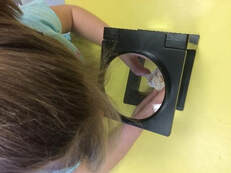 By Kimberly Olson Looking to See is a Donors Choose project based on the integration of Common Core and Next Generation Science Standards into my PK-grade 2 Art and Art History curriculum. Specifically, my goal for this project was to move toward the application of specific grade-level science standards in the areas of biomimicry, light & sound, motion and stability, and Earth's systems. In the project, students recognized the similarities between the design process and the science inquiry process through the use of hands-on art materials, experiments, engineering design challenges, and developing prototypes from sketches and block models. We explored materials collected from nature to develop skills in the areas of contour line drawing, texture, and form, to develop diagrams, and to ponder the intricacies of nature-made "architecture" to inspire our own inventions. Students explored our classroom nature lab in support of honing necessary shared observational skills spanning art and science. 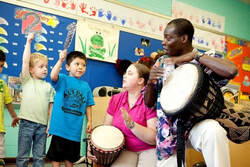 By Jennifer Edelen Early childhood STEM experiences can improve the diversity of students who demonstrate later-in-life involvement with STEM as a field. Engaging a broad range of learners with positive STEM experiences is essential to combating gaps in STEM achievement, an ongoing challenge that has been confirmed in studies, along race, socioeconomic status, and gender. By Ralph Tillinghast
As you canvas the country to identify STEM programs, one of the prevalent activities is robotics teams at the elementary, middle, and high school levels. Although the primary focus of these is STEM, many also incorporate STEAM into their programs. As these programs expand schools find that they need to work with all of the school departments, including visual art, graphic design, and business. Some of the teams even form subcommittees related to graphic design, t-shirts, marketing, for fundraising, team spirit, and promotional materials. A good example of this is a Flanders, New Jersey team known as MORT. Team Mort has had a long history in robotics competitions, fielding robots since 1996. Over the years, they've added a junior varsity team, MORT Beta. Combined, the teams have 130 students. The MORT teams have adopted the sub-committee model, having groups for programming, electrical, mechanical, business, marketing, and travel. Each year, the marketing team develops multiple t-shirts, stickers, and other marketing to use for fundraising and for lifting the team spirit during competitions at both their JV and Varsity levels. A quick scan of the Internet will lead you to a wide range of creative logo and t-shirt designs from other robotics teams from throughout the country. This creative application of marketing and graphics demonstrates how the arts can easily be integrated into STEM to build a more holistic systems approach to solving problems in multiple subject areas and broaden student learning at the same time. Ralph Tillinghast is a Collaborative member and is Lab Director, Collaboration Innovation Lab, US Army. STEAM Collaboration: National Art Education Association and the University of Alaska-Fairbanks12/18/2019 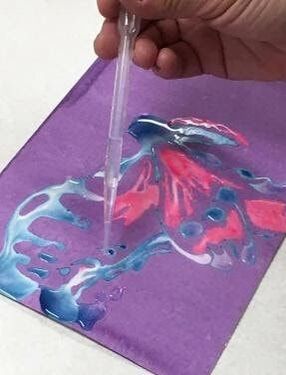 By Bob Reeker The National Art Education Association (NAEA), in collaboration with the University of Alaska-Fairbanks and the National Science Foundation, hosted its first of four STEAM workshops for educators on April 26-27, 2019, in Lincoln, Nebraska. Twenty-five educators from five states, in the fields of science, higher education, elementary academic classroom, community arts, and visual arts gathered for the two-day training that investigated a series of five units to explore with students. These investigations included paper marblizing, beet paper painting, red/blue/green light variations, animal habitats and coverings, and the use of ultraviolet light. Attendees received $200 in supplies to use towards STEAM investigations in their learning environments. On-line college credit was also available following the workshop. Dennis Inhulsen, NAEA Chief Learning Officer; Lorinda Rice, Lincoln Public Schools Art Consultant and NAEA Supervision and Administration Division Director, and Bob Reeker, Lincoln Public Schools art specialist and NAEA Western Region Vice President, hosted the event. The Fall, 2019, STEAM Workshop was in the Pacific Region in Provo, Utah, with workshops scheduled spring, 2020, in the Eastern Region and fall, 2020, in the Southeastern Region. Bob Reeker is the NAEA Western Region Vice President By Mary Dell’Erba
STEM Education has captured the attention of state policymakers who are concerned about preparing students for an evolving workforce. By 2030, the Institute for the Future estimates that 85 percent of the jobs that today’s K-12 learners will be doing haven’t been invented — demanding a workforce that is creative and prepared to respond innovatively to real-world problems. Thanks to generous support from the National Endowment for the Arts and the U.S. Department of Education, the Arts Education Partnership (a member of the Innovation Collaborative) has been expanding its work to explore the role of the arts in STEM. Since 2018, AEP has been exploring opportunities for STEAM in state and federal policy, and across the K-12 and higher education spectrums.  Here is a fascinating story of how curiosity led to the development of the inquiry process and a network of science education centers in national governments across sub-Saharan Africa. It is due, in large part, to the leadership and expertise of one of the Collaborative’s Research Thought Leaders, Hubert Dyasi, Ph.D. Curiosity What does curiosity have to do with the development of the inquiry process and a network of science education centers in national education departments throughout sub-Saharan Africa? One of the Collaborative’s Research Thought Leaders, Hubert Dyasi, Ph.D., originally from South Africa, and who was instrumental in developing the inquiry process and in setting up these centers, shares his experiences and insights. 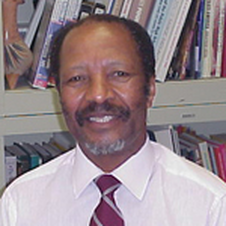 Interview by Lucinda Presley The Collaborative’s Research Thought Leaders help provide the strong foundation upon which the Collaborative’s work rests. Each Thought Leader is nationally and internationally recognized in his/her own field and brings an extensive depth of experience and expertise. They also are adept at working across disciplines. A Thought Leader and their work are featured in each Collaborative newsletter. In this issue, we visit with Hubert Dyasi, Ph.D., whose research in the teaching and learning of science, including the inquiry process, helps inform the work of the Collaborative. Hubert—now retired—was a professor of science education at the City College, City University of New York (CUNY). He is widely known for his teaching of science in pre-college education in the United States and Africa (see the “Curiosity Leads to Science Education Centers across Africa” article elsewhere in this newsletter) 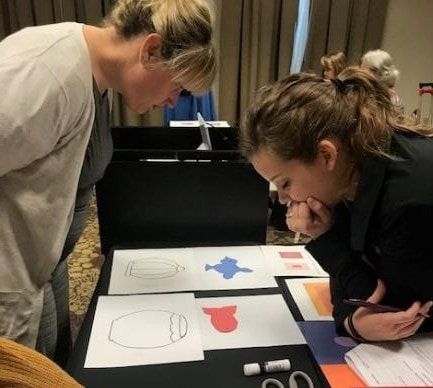 The Innovation Collaborative has received an additional National Endowment for the Arts Art Works grant of $10,000 during the 2019-20 school year. With this grant, it will study dissemination methods for sharing its effective practices in K-12 STEAM teacher professional development and classroom practices with the arts, STEM, and humanities fields. With NEA support, the Collaborative has studied these effective practices for the previous 2 years. Also, with NEA support, the Collaborative, in partnership with the National Writing Project, was able to convene its Research Thought Leaders in DC to initially strategize the underpinning for this work. The Collaborative is now ready to implement these practices on a broader scale. To do that, it developed a model for gaining school administrative support and dissemination. It convened in Houston, TX, its Innovation Fellows, the top teachers identified in its first round of research, and partner administrators. The Fellows, who have been developed as teacher leaders, will train their administrators in the Collaborative’s Rubrics, strategies, and thinking skills. Both Fellows and administrators will then help develop strategies to study models of all virtual vs. a hybrid of in-person and virtual professional development dissemination. Fellows and administrators, along with selected other administrators, will begin dissemination on their campuses or in their districts, recruiting other teachers to participate. Through this, the Collaborative will study the most effective methods and strategies for dissemination. In the process, the Collaborative’s research-based Rubrics and strategies will be made available for the arts, STEM, and humanities fields. In reflecting on this NEA grant, Collaborative Board Chair Lucinda Presley commented, “We continue to be especially grateful to the National Endowment for the Arts for its support of the Collaborative’s work. It is through NEA support that the Collaborative is able to develop a strong, research-based foundation for the rapidly-growing STEAM movement.” 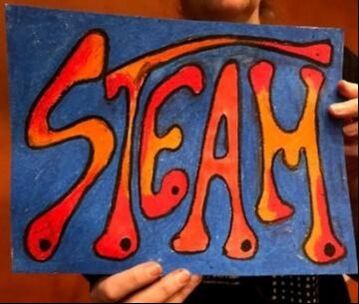 Artwork created in Fellows’ training that becomes 3D when viewed with diffraction grating glasses Artwork created in Fellows’ training that becomes 3D when viewed with diffraction grating glasses In Phase 2 of its 2015-16 K-12 Effective Practices Research Project (2015-16), made possible with support from the National Endowment for the Arts, the Collaborative identified 10 teachers nationally who most closely met its Effective Practices criteria. These criteria include problem-solving, analysis, synthesis, and processing skills across disciplines, in addition to life skills such as persistence and collaboration. These educators were designated Innovation Fellows and are being trained as teacher-leaders, with support from NEA funding. They completed their 3rd year in the Collaborative’s K-12 Effective Practices Project in May, 2019, helping to lead the project’s conceptualization, development, and implementation. Since their involvement with the project, 100% of the teachers have received significant professional recognition. They credit the Collaborative for helping foster these successes. These recognitions include:
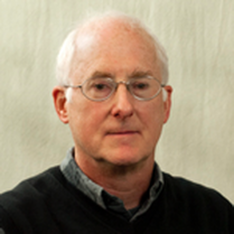 The Collaborative’s Research Thought Leaders help provide the strong foundation upon which the Collaborative’s work rests. Each Thought Leader is nationally and internationally recognized in his/her own field and brings an extensive depth of experience and expertise. They also are adept at working across disciplines. In this issue, we visit with Bob Root-Bernstein, whose research in the arts-sciences and scientific creativity helps underpin the work of the Collaborative. He is a Professor of Physiology at Michigan State University, where he conducts research on autoimmune diseases, the nature of scientific creativity, and arts-sciences. You can learn more about Bob here. In a conversation with Lucinda Presley, Collaborative Executive Director, Bob talked about his work and its relationship to the Collaborative. Lucinda: Tell us about how your arts-science research developed. Bob: I’ve been doing research in this field since graduate school in the 1980s. I always have been interested in many things. For example, although I majored in science at Princeton, I also am an artist and a musician. Like my parents, I am a polymath, with interest and expertise in a number of disciplines. I was interested in not just one narrow field, but in how disciplines intersected. I wanted to be a scientist, but I didn’t like the narrowness of the training. So, as a graduate student, I studied and received my doctorate in the history of science, which allowed me to work across disciplines. In my research, I saw that famous scientists such as Pasteur and Darwin also were artists and that it was these artistic skills that very positively impacted their work. For example, Darwin was polymathic, making breakthroughs in geology, geography, biology, and botany, and using photography as a scientific tool. Here are some resources where you can learn more about Bob Root-Bernstein’s research.
Root-Bernstein RS, Pathak A, Root-Bernstein MM. PART 1. A Review of Studies Demonstrating the Effectiveness of Integrating Arts, Music, Performing, Crafts and Design into Science, Technology, Engineering, Mathematics and Medical Education, Part 1: Summary of Evidence that Integration Is Professionally Useful and Effective. LEONARDO 2017: doi: 10.1162/LEON_a_01579 https://www.mitpressjournals.org/doi/abs/10.1162/LEON_a_01579 http://sead.viz.tamu.edu/pdf/RRB1.pdf Root-Bernstein RS, Pathak A, Root-Bernstein MM. PART II. Review of ACD-STEMM Integration, Part 2: Statistically-Validated and Controlled Pedagogical Studies of the Root-Bernstein’s “Tools for Thinking”. LEONARDO 2017: doi: 10.1162/LEON_a_01580 https://www.mitpressjournals.org/doi/abs/10.1162/LEON_a_01580 http://sead.viz.tamu.edu/pdf/RRB2.pdf Root-Bernstein RS, Pathak A, Root-Bernstein MM. PART III. Review of ACD-STEMM Integration, Part 3: Statistically-Validated and Controlled Pedagogical Studies of Eleven ACD-Integration Strategies Utilized by STEM Professionals and General Conclusions. LEONARDO 2017: doi: 10.1162/LEON_a_01581 https://www.mitpressjournals.org/doi/abs/10.1162/LEON_a_01581 http://sead.viz.tamu.edu/pdf/RRB3.pdf Root-Bernstein, R., et al. Arts Foster Scientific Success: Avocations of Nobel, National Academy, Royal Society, and Sigma Xi Members. Article (PDF Available) in Journal of Psychology of Science and Technology 1(2):51-63 · October 2008. https://www.researchgate.net/publication/247857346_Arts_Foster_Scientific_Success_Avocations_of_Nobel_National_Academy_Royal_Society_and_Sigma_Xi_Members Robert Root-Bernstein STEMM education should get “HACD”. Science 06 Jul 2018: Vol. 361, Issue 6397, pp. 22-23. DOI: 10.1126/science.aat8566 http://science.sciencemag.org/content/361/6397/22.summary Are you an out-of-school educator who is engaged in STEAM-based teaching?
Learning environments can range from after-school programs in community centers or school-sponsored field trips to summer camps or other experiences held outside the formal classroom. This research will look at the intersections of STEM and the arts as well as STEM and the humanities. If you are an out-of-school educator serving early childhood through higher education students, the Collaborative welcomes your participation in this important study. To find out more and to access a brief survey go here. It should take you 15 minutes or less to complete. Upon conclusion of the research study, an archive of validated strategies and tools will be available to help advance and refine STEAM teaching practice that can ensure maximum learning and success by students that ultimately will help promote vital innovative thinking skills. Over the last four years, the Innovation Collaborative has engaged in research activities investigating effective practices in integrating the arts with science, technology, engineering, math (STEM), and humanities, focusing on K-12 classroom implementations.
Phase I of the project involved the examination of Arts and STEM integrated lessons, units, and experiences. From this analysis the following themes were identified as most important to effective lessons: providing deep content knowledge in both STEM and Arts fields, connections across content areas, specific criteria for assessment, and collaborations between teachers and between students. Phase II of the project involved using the top lessons, units, and experiences that had been identified in Phase I to study the criteria in classroom settings. Phase III of the project, funded by the National Endowment for the Arts, involved providing professional development to the top K-12 teachers identified in Phase I, who then implemented high-quality lessons in their classrooms. This phase measured outcomes for teachers, students, and student products. It also led to the improvement of the rubrics to assess critical and creative thinking and arts integration of these lessons, units, and experiences. Collaborative’s NEA-funded K-12 Teacher Professional Development Study continues in 2018-193/1/2019 With the continued support from the National Endowment for the Arts, the Innovation Collaborative is continuing its K-12 Teacher Professional Development Study of STEAM-based learning and teaching in the 2018-19 academic year. Working with its Innovation Fellows, the top teachers identified in the first round of research in 2017-18, the project is now studying how to further develop teacher leaders and networks. During this second phase of the research, the Fellows selected teacher mentees whom they will help to develop their own STEAM-based teaching strategies.
The mentees assembled in Houston, TX, December 7-9, 2018, for an in-person workshop that focused on the content and methodology that will anchor their work in 2019. The Fellows, who will work with their mentees throughout the year, joined the workshop virtually. Collaborative Executive Director Lucinda Presley led the session. Also participating in the training were the grant’s researcher, Bess Wilson, the grant’s arts specialist, Fellow Juli Salzman from Angleton, TX ISD, and the science specialist, Dodie Resendez from Texas Education Agency Region IV in Houston. 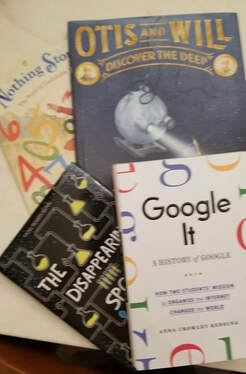 When educators move from traditional instruction to innovation, there are many structural challenges that can slow their progress. It’s not just a matter of teacher enthusiasm. They also need access to materials to support new ideas. The National Science Teachers Association’s (NSTA) four-year old effort to identify and encourage the best in children’s STEM literature was no exception. It would not be enough to recommend a few good books. The initiative was led by Missouri educator Carrie Launius. Among the goals were ways to encourage publishers to recognize how creativity and innovation could be fostered through reading, and to provide materials that met those goals. And, of course, they had to be confident that these books would sell. A well-publicized national competition would go a long way to accomplishing these goals. Towards that end, in 2014, NSTA, working in partnership with the Children’s Book Council, set out to recognize and encourage the best in STEM process-based literature. To begin, they had to develop a rubric featuring criteria that didn’t focus on content. The structure of the publishing industry doesn’t easily adapt to new ideas and new genres—especially when their use in the classroom has not yet demonstrated profitability. Trade books that are used to support various school content areas (like science or engineering) are often marketed and sold by specialized sales reps in those areas. Very few teachers use reading to support lessons in mathematics or technology (coding) so there isn’t an easy path to creating that niche. The rubric would have to clearly encourage publications that emphasized creativity and problem-solving “habits of mind.” |
